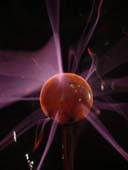
Purpose
To find out how static electricity is produced. After this experiment you will be able to differentiate static electricity from current electricity and answer the question, “What kind of electricity is produced when you rub two materials of different kinds?”
Additional information
There are two kinds of electricity namely static and current electricity. Static electricity or electricity at rest is a kind of electricity produced when you rub and stroke two different materials especially non-metals. They attract light objects such as small bits of paper and cotton thread to them. It is a form of electricity that does not flow but stays fixed on a certain location. It is very different from electricity that flows in wires like the one used to operate our appliances at home. Rubbing materials causes electrons to move. This results in materials becoming positively or negatively charged. Objects having opposite charges attract while those with the same charges repel. In addition, static electricity is produced by friction and is only present temporarily.
Sponsored Links
Required materials
- comb
- small pieces of paper
- dry woolen cloth
- inflated balloon
- sand
Estimated Experiment Time
Around 15 minutes.
Step-By-Step Procedure
- 1. Bring your comb near small pieces of paper and observe what happens.
- 2. Now rub your comb briskly with a dry woolen cloth.
- 3. Bring the comb towards some tiny pieces of paper and write down your observation.
- 4. Rub an inflated balloon with a woolen cloth.
- 5. Put the balloon against the wall and observe what happens.
- 6. Rub the balloon with the woolen cloth again.
- 7. Hold the balloon over very dry fine sand.
Note
Make sure you perform the experiment in an enclosed area to prevent sand and paper from getting carried away by wind. Be careful not to play with the sand since it can get into your eyes.
Observation
What happened when you bring your comb near small pieces of paper? What happened when you rubbed your comb with the cloth and brought it near the pieces of paper? Compare your observation with the first step. What caused the balloon to stick on the wall? Do you think the same thing will happen without rubbing the balloon on the cloth first? What happens to the sand when you bring the balloon near it? What kind of electricity is produced?
Result
The pieces of paper did not react to the comb in the first step but after rubbing the comb with the cloth, the comb gained negative electrons so it becomes negatively charged and attracted the pieces of paper. The balloon stuck on the wall because it is negatively charged while the wall is positively charged. It will not do so if it is not rubbed with a woolen cloth. The same thing happened when in rubbing the balloon and holding it over fine sand. The balloon attracted the sand. This kind of electricity that stays fixed on a location is known as static electricity or electricity at rest.
Sponsored Links
Take a moment to visit our table of Periodic Elements page where you can get an in-depth view of all the elements,
complete with the industry first side-by-side element comparisons!